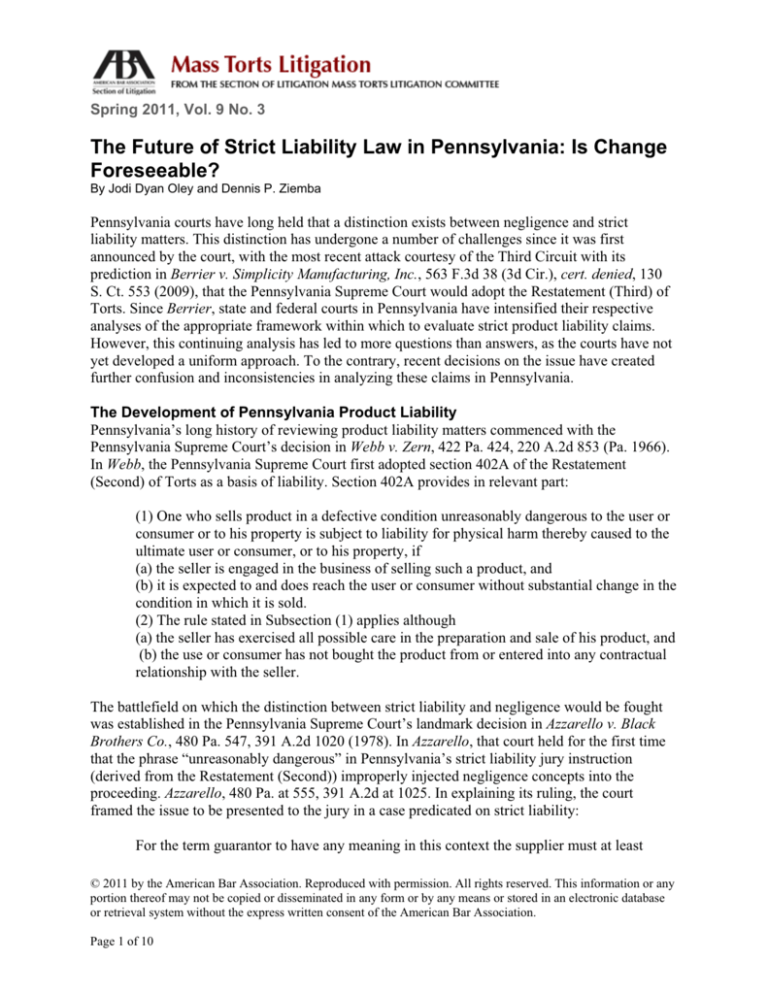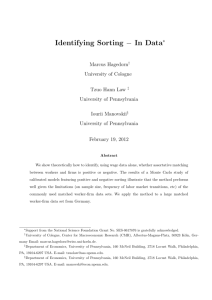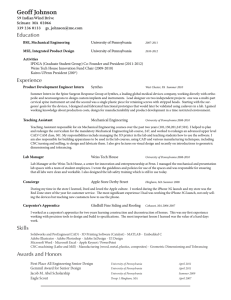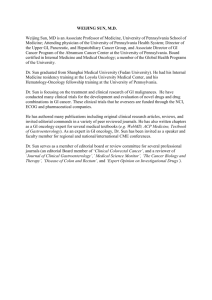
Spring 2011, Vol. 9 No. 3
The Future of Strict Liability Law in Pennsylvania: Is Change
Foreseeable?
By Jodi Dyan Oley and Dennis P. Ziemba
Pennsylvania courts have long held that a distinction exists between negligence and strict
liability matters. This distinction has undergone a number of challenges since it was first
announced by the court, with the most recent attack courtesy of the Third Circuit with its
prediction in Berrier v. Simplicity Manufacturing, Inc., 563 F.3d 38 (3d Cir.), cert. denied, 130
S. Ct. 553 (2009), that the Pennsylvania Supreme Court would adopt the Restatement (Third) of
Torts. Since Berrier, state and federal courts in Pennsylvania have intensified their respective
analyses of the appropriate framework within which to evaluate strict product liability claims.
However, this continuing analysis has led to more questions than answers, as the courts have not
yet developed a uniform approach. To the contrary, recent decisions on the issue have created
further confusion and inconsistencies in analyzing these claims in Pennsylvania.
The Development of Pennsylvania Product Liability
Pennsylvania’s long history of reviewing product liability matters commenced with the
Pennsylvania Supreme Court’s decision in Webb v. Zern, 422 Pa. 424, 220 A.2d 853 (Pa. 1966).
In Webb, the Pennsylvania Supreme Court first adopted section 402A of the Restatement
(Second) of Torts as a basis of liability. Section 402A provides in relevant part:
(1) One who sells product in a defective condition unreasonably dangerous to the user or
consumer or to his property is subject to liability for physical harm thereby caused to the
ultimate user or consumer, or to his property, if
(a) the seller is engaged in the business of selling such a product, and
(b) it is expected to and does reach the user or consumer without substantial change in the
condition in which it is sold.
(2) The rule stated in Subsection (1) applies although
(a) the seller has exercised all possible care in the preparation and sale of his product, and
(b) the use or consumer has not bought the product from or entered into any contractual
relationship with the seller.
The battlefield on which the distinction between strict liability and negligence would be fought
was established in the Pennsylvania Supreme Court’s landmark decision in Azzarello v. Black
Brothers Co., 480 Pa. 547, 391 A.2d 1020 (1978). In Azzarello, that court held for the first time
that the phrase “unreasonably dangerous” in Pennsylvania’s strict liability jury instruction
(derived from the Restatement (Second)) improperly injected negligence concepts into the
proceeding. Azzarello, 480 Pa. at 555, 391 A.2d at 1025. In explaining its ruling, the court
framed the issue to be presented to the jury in a case predicated on strict liability:
For the term guarantor to have any meaning in this context the supplier must at least
© 2011 by the American Bar Association. Reproduced with permission. All rights reserved. This information or any
portion thereof may not be copied or disseminated in any form or by any means or stored in an electronic database
or retrieval system without the express written consent of the American Bar Association.
Page 1 of 10
Spring 2011, Vol. 9 No. 3
provide a product which is designed to make it safe for the intended use. Under this
standard, in this type case, the jury may find a defect where the product left the supplier’s
control lacking any element necessary to make it safe for its intended use or possessing
any feature that renders it unsafe for the intended use. It is clear that the term
“unreasonably dangerous” has no place in the instructions to a jury as to the question of
“defect” in this type of case.
Id. at 558, 391 A.2d at 1027.
Since Azzarello, Pennsylvania’s courts have gone to great lengths to keep negligence and strict
liability concepts separate. In fact, courts have declared that “negligence concepts have no place
in a case based on strict liability.” Lewis v. Coffing Hoist Div., Duff-Norton Co., Inc., 515 Pa.
334, 528 A.2d 590, 593 (Pa. 1987). The Pennsylvania Supreme Court in Kimco Development
Corp. v. Michael D’s Carpet Outlets stressed that the court had been “adamant” that negligence
and strict liability concepts must remain separate:
Our position is not based solely on the problem of the conceptual confusion that would
ensue should negligence and strict liability concepts be commingled, although that
concern is not negligible. Rather, we think that the underlying purpose of strict product
liability is undermined by introducing negligence concepts into it. Strict product liability
is premised on the concept of enterprise liability for casting a defective product into the
stream of commerce.
536 Pa. 1, 8, 637 A.2d 603, 606 (1993).
The extent of the negligence/strict liability debate in Pennsylvania is highlighted by the
Pennsylvania Supreme Court’s decision in Phillips v. Cricket Lighters, 576 Pa. 644, 841 A.2d
1000 (2003). In Phillips, the court declined to extend strict liability to any “reasonably
foreseeable user,” finding that doing so would “improperly import negligence concepts into strict
liability law.” Id.at 657, 841 A.2d at 1007.
However, the Pennsylvania Supreme Court presented a less-than-unified front on this issue.
Justice Saylor wrote a concurring decision that raised his concerns over the “tension” between
foreseeability in negligence and strict liability under section 402A of the Restatement (Second).
Justice Saylor noted that the proclamation that “negligence concepts have no place in strict
liability law” is disproved on the face of the majority’s own analysis, as most courts and
commentators have come to realize that, in design cases, the character of the product and the
conduct of the manufacturer are largely inseparable. Id. at 669, 841 A.2d at 1015. While Justice
Saylor concurred in the majority’s holding, under existing law, he believed that the law of the
commonwealth demonstrated the need for consideration of reasoned alternatives, such as the
Third Restatement:
© 2011 by the American Bar Association. Reproduced with permission. All rights reserved. This information or any
portion thereof may not be copied or disseminated in any form or by any means or stored in an electronic database
or retrieval system without the express written consent of the American Bar Association.
Page 2 of 10
Spring 2011, Vol. 9 No. 3
In my view, adoption of the Restatement’s closely reasoned and balanced approach,
which synthesizes the body of products liability law into a readily accessible formulation
based on the accumulated wisdom from thirty years of experience, represents the clearest
path to reconciling the difficulties persisting in Pennsylvania law, while enhancing
fairness and efficacy in the liability scheme.
Id. at 675, 679, 841 A.2d at 1018–19, 1021.
Pennsylvania Department of General Services v. U.S. Mineral Products Co.
This distinction was further reiterated by the Supreme Court in Pennsylvania Department of
General Services v. U.S. Mineral Products Co., 587 Pa. 236, 898 A.2d 590 (2006) (DGS). In
DGS, a fire damaged an office building containing materials that generated polychlorinated
biphenyls (PCBs) when burned. Id. at 241–43; 898 A.2d at 593–94. The plaintiff filed suit
against the manufacturer of the building materials, alleging claims of negligence and strict
product liability for costs in constructing a new building and the loss of personal property in the
fire. The case went to trial on the strict product liability claim only. One of the jury instructions
“given to the jurors explicitly or implicitly authorized them to evaluate the evidence to determine
whether the fire could be considered to have been a reasonably foreseeable event against which
the [manufacturer] should have guarded.” Id. at 253, 898 A.2d at 600. The jury returned a verdict
for the plaintiff.
On appeal, the Pennsylvania Supreme Court held that the trial court erred by instructing the jury
to evaluate evidence of whether the incident could have been a reasonably foreseeable event. The
state supreme court reasoned that this was erroneous because Pennsylvania does not recognize a
strict product liability cause of action arising from an unintended use, even when the unintended
use is foreseeable. A majority of the court noted in that, based on the conclusion of the
concurring justices in Phillips, including that of Justice Saylor, “there are substantial deficiencies
in the present strict liability doctrine [and] it should be closely limited pending an overhaul by
the Court.” Id. at 254, 898 A.2d at 601.
The Berrier Decision
Against this backdrop, the Third Circuit took on the issue in Berrier v. Simplicity Manufacturing,
Inc. and predicted that the Pennsylvania Supreme Court would adopt sections 1 and 2 of the
Restatement (Third) of Torts, permitting a cause of action in strict liability to all “foreseeable
persons” who are affected by a defective product. 563 F.3d at 56.
The plaintiff, a minor, was injured when her grandfather engaged the blades of a riding mower in
reverse and backed over her leg, causing injuries that led to the amputation of her foot. The
riding mower was manufactured by defendant Simplicity Manufacturing. Id. at 40–41.
Following the incident, the parents filed suit against Simplicity, alleging negligence and strict
liability theories. Simplicity filed a motion for summary judgment, which was granted by the
© 2011 by the American Bar Association. Reproduced with permission. All rights reserved. This information or any
portion thereof may not be copied or disseminated in any form or by any means or stored in an electronic database
or retrieval system without the express written consent of the American Bar Association.
Page 3 of 10
Spring 2011, Vol. 9 No. 3
district court as to the strict liability claim. Id. at 45. The district court held that Pennsylvania’s
product liability law did not permit recovery for the child’s injuries because she was a bystander,
not an intended user of the riding mower, and the plaintiffs appealed.
On appeal, the Third Circuit first attempted to certify foundational questions concerning
Pennsylvania product liability law to the Pennsylvania Supreme Court, but the court refused the
certification. See id. at 60 n.33. Forced to decide the issue on its own, the Third Circuit found
that no other Pennsylvania decision specifically addressed the issue of liability for bystander
injury under Pennsylvania strict liability law, and, therefore, it had to predict how Pennsylvania’s
supreme court would decide the case. Id. at 45–46. The Third Circuit noted that while the
Pennsylvania Supreme Court had not expressly recognized a bystander’s right to recover under
Pennsylvania’s product liability law, it had not expressly rejected such a claim either.
In predicting the future course of product liability in Pennsylvania, the Third Circuit applied the
Restatement (Third) and interpreted it as not limiting a strict liability cause of action to the user
or consumer, but as broadly permitting any person harmed by a defective product to recover in
strict liability. Id. at 54–55.
Sections 1 and 2 of the Restatement (Third) of Torts, in relevant part, read as follows:
One engaged in the business of selling or otherwise distributing products who sells or
distributes a defective product is subject to liability for harm to persons or property
caused by the defect.
A product is defective when at the time of sale or distribution, it contains a manufacturing
defect, is defective in design, or is defective because of inadequate instructions or
warnings.
A product:
(a) contains a manufacturing defect when the product departs from its intended design
even though all possible care was exercised in the preparation and marketing of the
product;
(b) is defective in design when the foreseeable risks of harm posed by the product could
have been reduced or avoided by the adoption of a reasonable alternative design by the
seller or other distributor, or a predecessor in the commercial chain of distribution, and
the omission of the alternative design renders the product not reasonably safe;
(c) is defective because of inadequate instructions or warnings when the foreseeable risks
of harm posed by the product could have been reduced or avoided by the provision of the
© 2011 by the American Bar Association. Reproduced with permission. All rights reserved. This information or any
portion thereof may not be copied or disseminated in any form or by any means or stored in an electronic database
or retrieval system without the express written consent of the American Bar Association.
Page 4 of 10
Spring 2011, Vol. 9 No. 3
reasonable instructions or warnings by the seller or other distributor, or a predecessor in
the commercial chain of distribution, and the omission of the instructions or warnings
renders the product not reasonably safe.
The court determined that the Third Restatement would eliminate much of the confusion created
in Pennsylvania by attempting to insulate negligence concepts from strict liability claims.
The Third Circuit found Justice Newman’s dissent in DGS, along with Justice Saylor’s
concurring opinion in Phillips, to be compelling evidence that there is substantial support in the
Pennsylvania Supreme Court to adopt the Third Restatement’s approach to product liability. Id.
at 57. Based on the above, the Third Circuit was convinced that the Pennsylvania Supreme Court
will adopt Justice Saylor’s concurring opinion and find that concepts from negligence are
embedded in strict product liability in Pennsylvania and that the character of the product and the
conduct of the manufacturer are largely inseparable. The Third Circuit reasoned that it is
difficult, if not impossible, to determine whether a product is safe for its intended use by an
intended user without any consideration of foreseeability.
After predicting how the Pennsylvania Supreme Court would decide the issue, the Third Circuit
turned its attention to applying the Third Restatement to the facts of the Berrier case. It began by
stating that the unintended user doctrine was not implicated by this particular situation. Instead,
this matter deals with bystander recovery, which has been allowed by district courts in
Pennsylvania under section 402A. Id. at 57–58. See, e.g., Fedorchick v. Massey-Ferguson, Inc.,
438 F. Supp. 60, 62–63 (E.D. Pa. 1997), aff’d, 577 F.3d 725 (3d Cir. 1978).
The Third Circuit did not find that these district court decisions were in any way altered by
Phillips or DGS, as those Pennsylvania cases only addressed unintended users, not bystanders.
Berrier, 563 F.3d at 59–60. The Third Circuit further reasoned that the policy considerations
recognized since Webb would not deny strict liability claims to spectators or bystanders, where it
had previously allowed recovery by passengers. Such illogical results are avoided by the
application of sections 1 and 2 of the Third Restatement. The Third Circuit therefore concluded
that “the time has come for this Court . . . to expressly recognize the essential role of risk-utility
balancing, a concept derived from negligence doctrine, in design defect litigation.” Id. at 60
(internal citations omitted).
The Third Circuit predicted that the Pennsylvania Supreme Court would agree that the Third
Restatement illuminates the most viable route to providing essential clarification and remediation
of the conflict between negligence and strict liability. The court also held that while Justice
Saylor referred only to section 2 of the Third Restatement, it was highly likely that the justices
who would adopt section 2 would also adopt section 1, rather than try to parse the applicable
provisions of the Third Restatement and supplant some of the provisions of the Second
Restatement and not others.
© 2011 by the American Bar Association. Reproduced with permission. All rights reserved. This information or any
portion thereof may not be copied or disseminated in any form or by any means or stored in an electronic database
or retrieval system without the express written consent of the American Bar Association.
Page 5 of 10
Spring 2011, Vol. 9 No. 3
Based on the above reasoning, the Third Circuit vacated the district court’s grant of summary
judgment as to the plaintiffs’ strict liability claims in light of the prediction that the Pennsylvania
Supreme Court would adopt the Third Restatement allowing a bystander to bring a strict liability
claim against the manufacturer.
The Repercussions of Berrier
Recent State Court Decisions
Following the Berrier decision, the Pennsylvania Supreme Court came face-to-face with the
precise issue reinvigorated by the Third Circuit in Berrier—and blinked. In Bugosh v. I.U. North
America, Inc., 942 A.2d 897 (Pa. 2008) (per curiam), the Pennsylvania Supreme Court
considered an appeal that included “whether this Court should apply Section 2 of the
Restatement (Third) of Torts in place of Section 402A of the Restatement (Second) of Torts.”
Bugosh, 942 A.2d at 898. Unfortunately for litigators, over a year after the Petition for
Allowance of Appeal was granted, the Pennsylvania Supreme Court opted to dismiss the appeal
as improvidently granted, rather than take on the challenge to resolve this long-standing debate.
Bugosh v. I.U. N. Am., Inc., 971 A.2d 1228, 1229 (Pa. 2009). At oral argument, it had become
clear that the defendant was not a product manufacturer but, rather, an intermediate seller, thus
precluding the court from addressing the underlying Restatement questions, which did not apply
to intermediate sellers. See Restatement (Third) of Torts, Products Liability § 2 cmt. o (1997).
Justice Saylor did not allow this dismissal to pass quietly. In a dissenting opinion, Justice Saylor
expressed his belief that the decision in Azzarello was severely deficient and should be
overruled. 971 A.2d at 1229 (Saylor, J., dissenting). Justice Saylor stated that the status quo
creates a serious misalignment between the descriptions of Pennsylvania’s strict liability doctrine
and the doctrine’s actual operation. Id. at 1234. Although the decision in Azzarello had good
intentions, Justice Saylor found that it has been unworkable and impeded the progress of
Pennsylvania’s product liability jurisprudence. Id. at 1239. In contrast, Justice Saylor supported
application of the Restatement (Third) in Pennsylvania, finding it more reasoned and balanced.
He further opined that it would advance product liability law in Pennsylvania. Id. at 1240.
According to Justice Saylor, “[T]he Restatement [Third] provides a suitable template for making
up for lost time and moving forward.” Id.
The Pennsylvania Supreme Court’s denial of the appeal in Bugosh, when evaluated in light of the
Third Circuit’s decision in Berrier, has now left an even greater sense of discord in Pennsylvania
strict liability law. State courts, bound by Azzarello, had to apply one standard, while federal
courts, bound by Berrier, were obligated to apply another. This apparent conflict has created
even further confusion for practitioners in reviewing post-Bugosh and post-Berrier decisions.
After the appeal in Bugosh was dismissed, the defendant in Berrier filed a motion for rehearing
in the Third Circuit, arguing that the adoption of the Third Restatement should be reconsidered
because, contrary to prior expectations, the Pennsylvania Supreme Court had not resolved the
© 2011 by the American Bar Association. Reproduced with permission. All rights reserved. This information or any
portion thereof may not be copied or disseminated in any form or by any means or stored in an electronic database
or retrieval system without the express written consent of the American Bar Association.
Page 6 of 10
Spring 2011, Vol. 9 No. 3
issue. The Third Circuit declined to reconsider its prediction in Berrier. Berrier v. Simplicity
Mfg., Inc., No. 05-3621 (3d Cir. Sept. 29, 2009) (unpublished per curiam order).
Pennsylvania’s state courts appear to remain within the “Azzarello camp,” applying the
Restatement (Second) in strict liability matters. However, this application is not without
resistance.
In French v. Commonwealth Assocs., Inc., 980 A.2d 623, 629 n.3 (Pa. Super. 2009), the Superior
Court mentioned in passing that by dismissing the appeal in Bugosh as improvidently granted,
the Pennsylvania Supreme Court declined to “substantially alter the legal responsibility scheme
grounded on Azzarello,” leaving section 402A of the Restatement (Second) of Torts to section 2
the law in Pennsylvania. French, 980 A.2d at 629 n.3. See also Kiak v. Crown Equip. Corp., 989
A.2d 385, 389 n.1 (Pa. Super. 2009) (adhering to Azzarello); Estate of Hicks v. Dana Cos., LLC,
984 A.2d 943, 975–76 (Pa. Super. 2009) (same).
More recently, the Pennsylvania Supreme Court issued a decision in Barnish v. KWI Building
Co., 980 A.2d 535 (Pa. 2009), a strict liability case, without even a mention of the
Berrier/Bugosh conflict in Justice Baer’s opinion. In deciding the significance of a product’s
prior successful use in deciding a plaintiff’s ability to withstand summary judgment in a
malfunction theory case, the court applied the Restatement (Second) of Torts, Barnish, 980 A.2d
at 546, and held that that the plaintiffs failed to meet their burden under section 402A of the
Restatement (Second) of Torts because they could not present evidence from which a reasonable
jury could conclude that an unspecified defect existed when the spark detection system left the
manufacturer’s control. Id. at 543.
While the dispute was not directly addressed, Justice Saylor once again raised the issue of the
status of Pennsylvania’s strict liability law in a concurring decision, joined by Justice Castille.
Justice Saylor noted that “the proper approach to the foundational elements of a strict-liability
claim is a subject in current controversy in this Court.” Id. at 549 (Saylor, J., concurring)
(emphasis added).
The Pennsylvania Supreme Court’s most recent product liability decision, Schmidt v. Boardman,
11 A.3d 924 (Pa. 2011), once again alluded to the unsettled state of the law, but once again
avoided resolving it:
Notwithstanding the Third Circuit’s prediction [in Berrier], however, the present status
quo in Pennsylvania entails the continued application of Section 402A of the Restatement
Second, subject to the admonition that there should be no further judicial expansions of
its scope under current strict liability doctrine. See DGS, 587 Pa. at 254 & n.10, 898 A.2d
at 601 & n.10. This case was not selected to address the foundational concerns, and,
accordingly, the pathways to global resolution are not developed in significant detail in
the briefing. Thus, we can do little more here than to remark that the difficulties persist,
© 2011 by the American Bar Association. Reproduced with permission. All rights reserved. This information or any
portion thereof may not be copied or disseminated in any form or by any means or stored in an electronic database
or retrieval system without the express written consent of the American Bar Association.
Page 7 of 10
Spring 2011, Vol. 9 No. 3
and to proceed to address the specific questions presented with them—and DGS’s
admonition—in mind.
Id. at 941.
Recent Federal Court Decisions
Recent pronouncements from the federal bench have only further confused the issue. In Richetta
v. Stanley Fastening Systems, L.P., Judge Golden of the Eastern District of Pennsylvania
followed Berrier and applied the Restatement (Third). 661 F. Supp.2d 500 (E.D. Pa. 2009).
Richetta expanded on Berrier, reasoning that Berrier was not limited to cases involving
bystanders. The court noted that “Berrier merely provided an appropriate vehicle for the Third
Circuit to predict that the Third Restatement applies under Pennsylvania law.” Id. at 506.
In Hoffman v. Paper Converting Machine Co., 694 F. Supp. 2d 359 (E.D. Pa. 2010), Judge
Petrese Tucker, formerly of the Court of Common Pleas, also followed the Third Circuit’s
prediction in Berrier. Id. at 365. Judge Tucker applied the Third Restatement to a strict liability
matter involving alleged design defects in a printing press. Judge Tucker found that because the
Pennsylvania Supreme Court dismissed the Bugosh appeal on procedural grounds, Berrier
controlled as binding precedent:
The Court notes that there is a divergence among district courts regarding whether the
Restatement (Second) of Restatement (Third) should apply, and finds that because the
Pennsylvania Supreme Court decision in Bugosh was merely a procedural dismissal of
the matter, the absence of a substantive decision renders the Third Circuit’s decision in
Berrier binding precedent. As such, the Restatement (Third) applies.
Id. Judge Diamond reached the same conclusion in Covell v. Bell Sports, Inc., 2010 WL 4783043
(E.D. Pa. Sept. 8, 2010):
Berrier . . . based its determination that the Pennsylvania Supreme Court would adopt the
Third Restatement not upon the pendency of the Bugosh appeal itself, but rather upon
relevant state precedents, analogous decisions, considered dicta, scholarly works, and
other reliable data tending convincingly to show how the highest court in the state would
decide the issue at hand. Accordingly, the procedural dismissal of Bugosh does not
impugn the determination in Berrier.
Id. at *4. Accord Martinez v. Skirmish, U.S.A., Inc., 2009 WL 1676144, at *16 (E.D. Pa. June 15,
2009) (applying Third Restatement under Berrier) (Padova, J.).
However, a mere month after Richetta, Magistrate Hart, also of the Eastern District, held the
opposite—that Pennsylvania would not adopt the Restatement (Third) of Torts. See Durkot v.
© 2011 by the American Bar Association. Reproduced with permission. All rights reserved. This information or any
portion thereof may not be copied or disseminated in any form or by any means or stored in an electronic database
or retrieval system without the express written consent of the American Bar Association.
Page 8 of 10
Spring 2011, Vol. 9 No. 3
Tesco Equip., LLC, 654 F. Supp. 2d 295 (E.D. Pa. 2009). Magistrate Hart reasoned that the
“federal court may not impose its view of what the state law should be, but must apply existing
state law as interpreted by the state’s highest court.” Id. at 298. He noted that to apply the
Restatement (Third) when the Pennsylvania Supreme Court declined to change the law in
Bugosh as predicted by the Third Circuit would mean that different standards would be applied
to strict liability cases depending on whether the case was brought in state court or federal court.
Id. at 298–99. Magistrate Hart held that because the Pennsylvania Supreme Court failed to take
action in line with the Berrier opinion, section 402A of the Restatement (Second) of Torts
remains the law in Pennsylvania, and the Third Circuit’s prediction in Berrier could be ignored.
Id. at 299.
Judge Jones of the Middle District of Pennsylvania also declined to follow the Berrier prediction
in Milesco v. Norfolk Southern Corp., No. 1:09-cv-1233, 2010 U.S. Dist. Lexis 780 (M.D. Pa.
Jan. 5, 2010). In concluding that the Restatement (Second) controls product liability actions in
Pennsylvania, the court rationalized the Berrier/Bugosh debate as follows:
It is important to note that the action of the Pennsylvania Supreme Court was not
accompanied by any rationale in support thereof, meaning that it never affirmatively
passed judgment on the prudence of adopting the [Restatement (Third)] as the law in
Pennsylvania. Nonetheless, certain conclusions can be reasonably distilled therefrom.
Namely, it is instructive that when faced with the opportunity to supplant the
[Restatement (Second)] with the [Restatement (Third)] the Pennsylvania Supreme Court
declined the invitation to do so. While there could have been numerous reasons
undergirding this decision, some of which may have had nothing to do with the
contemplated supersession in the abstract, the dismissal of the appeal unmistakably
indicates that such supersession is anything but a certainty. Consequently, taken in
context, we believe that the Pennsylvania Supreme Court’s dismissal of Bugosh was a
clear indication that it intends for the [Restatement (Second)] to apply in the
Commonwealth for the time being.
Id.at *9–10. The anti-Berrier side has been joined by Thompson v. Med-Mizer, Inc., 2011 WL
1085621, at *7 (E.D. Pa. Mar. 21, 2011) (Gardner, J.); Sweitzer v. Oxmaster, Inc., 2010 WL
5257226, at *4–5 (E.D. Pa. Dec. 23, 2010) (Pratter, J.); McGonigal v. Sears Roebuck & Co.,
2009 WL 2137210, at *4–5 (E.D. Pa. July 16, 2009) (Rice, Mag. J.).
In reviewing recent post-Berrier and post-Bugosh decisions, it appears that state courts have
unanimously opted to apply the “status quo” of the Restatement (Second). The federal courts are
deeply split, and the Third Circuit will ultimately have to resolve the fate of its perhaps
premature prediction in Berrier—possibly with another attempt to certify the question to the
Pennsylvania Supreme Court. However, it is clear from Justice Saylor’s dissent in Bugosh and
concurrence in Barnish (both opinions joined by Chief Justice Castille), and the most recent
© 2011 by the American Bar Association. Reproduced with permission. All rights reserved. This information or any
portion thereof may not be copied or disseminated in any form or by any means or stored in an electronic database
or retrieval system without the express written consent of the American Bar Association.
Page 9 of 10
Spring 2011, Vol. 9 No. 3
observations in Schmidt, that at least two, and possibly as many as four, members of
Pennsylvania’s Supreme Court believe that Pennsylvania’s courts should adopt the Restatement
(Third) in strict liability matters. Until the Pennsylvania Supreme Court speaks definitively on
the issue, change in Pennsylvania strict liability law remains foreseeable.
Jodi Dyan Oley and Dennis P. Ziemba are with Eckert Seamens in Philadelphia, Pennsylvania.
© 2011 by the American Bar Association. Reproduced with permission. All rights reserved. This information or any
portion thereof may not be copied or disseminated in any form or by any means or stored in an electronic database
or retrieval system without the express written consent of the American Bar Association.
Page 10 of 10






